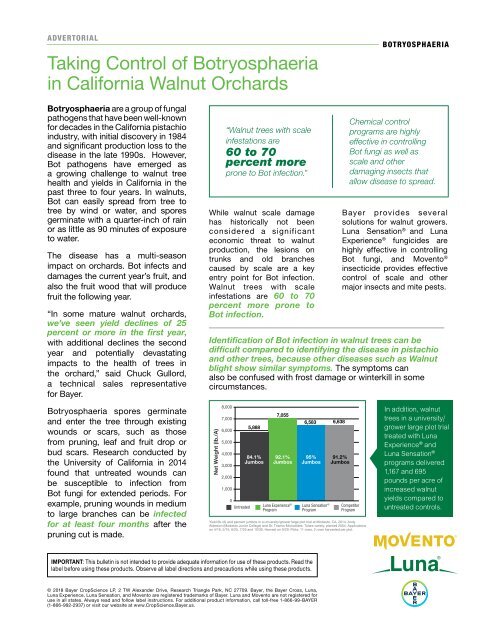Create successful ePaper yourself
Turn your PDF publications into a flip-book with our unique Google optimized e-Paper software.
ADVERTORIAL<br />
Taking Control of Botryosphaeria<br />
in California Walnut Orchards<br />
BOTRYOSPHAERIA<br />
Botryosphaeria are a group of fungal<br />
pathogens that have been well-known<br />
for decades in the California pistachio<br />
industry, with initial discovery in 1984<br />
and significant production loss to the<br />
disease in the late 1990s. However,<br />
Bot pathogens have emerged as<br />
a growing challenge to walnut tree<br />
health and yields in California in the<br />
past three to four years. In walnuts,<br />
Bot can easily spread from tree to<br />
tree by wind or water, and spores<br />
germinate with a quarter-inch of rain<br />
or as little as 90 minutes of exposure<br />
to water.<br />
The disease has a multi-season<br />
impact on orchards. Bot infects and<br />
damages the current year’s fruit, and<br />
also the fruit wood that will produce<br />
fruit the following year.<br />
“In some mature walnut orchards,<br />
we’ve seen yield declines of 25<br />
percent or more in the first year,<br />
with additional declines the second<br />
year and potentially devastating<br />
impacts to the health of trees in<br />
the orchard,” said Chuck Gullord,<br />
a technical sales representative<br />
for Bayer.<br />
Botryosphaeria spores germinate<br />
and enter the tree through existing<br />
wounds or scars, such as those<br />
from pruning, leaf and fruit drop or<br />
bud scars. Research conducted by<br />
the University of California in 2014<br />
found that untreated wounds can<br />
be susceptible to infection from<br />
Bot fungi for extended periods. For<br />
example, pruning wounds in medium<br />
to large branches can be infected<br />
for at least four months after the<br />
pruning cut is made.<br />
“Walnut trees with scale<br />
infestations are<br />
60 to 70<br />
percent more<br />
prone to Bot infection.”<br />
While walnut scale damage<br />
has historically not been<br />
considered a significant<br />
economic threat to walnut<br />
production, the lesions on<br />
trunks and old branches<br />
caused by scale are a key<br />
entry point for Bot infection.<br />
Walnut trees with scale<br />
infestations are 60 to 70<br />
percent more prone to<br />
Bot infection.<br />
Chemical control<br />
programs are highly<br />
effective in controlling<br />
Bot fungi as well as<br />
scale and other<br />
damaging insects that<br />
allow disease to spread.<br />
Bayer provides several<br />
solutions for walnut growers.<br />
Luna Sensation ® and Luna<br />
Experience ® fungicides are<br />
highly effective in controlling<br />
Bot fungi, and Movento ®<br />
insecticide provides effective<br />
control of scale and other<br />
major insects and mite pests.<br />
Identification of Bot infection in walnut trees can be<br />
difficult compared to identifying the disease in pistachio<br />
and other trees, because other diseases such as Walnut<br />
blight show similar symptoms. The symptoms can<br />
also be confused with frost damage or winterkill in some<br />
circumstances.<br />
Net Weight (lb./A)<br />
8,000<br />
7,000<br />
6,000<br />
5,000<br />
4,000<br />
3,000<br />
2,000<br />
1,000<br />
5,888<br />
84.1%<br />
Jumbos<br />
7,055<br />
92.1%<br />
Jumbos<br />
6,583 6,638<br />
95%<br />
Jumbos<br />
0<br />
Untreated Luna Experience ® Luna Sensation ®<br />
Program<br />
Program<br />
91.2%<br />
Jumbos<br />
Competitor<br />
Program<br />
Yield (lb./A) and percent jumbos in a university/grower large plot trial at Modesto, CA, 2014. Andy<br />
Alderson (Modesto Junior College) and Dr. Themis Michailides. Tulare variety, planted 2004. Applications<br />
on 4/16, 5/15, 6/25, 7/25 and 10/30. Harvest on 9/29. Plots: 11 rows, 2 rows harvested per plot.<br />
In addition, walnut<br />
trees in a university/<br />
grower large plot trial<br />
treated with Luna<br />
Experience ® and<br />
Luna Sensation ®<br />
programs delivered<br />
1,167 and 695<br />
pounds per acre of<br />
increased walnut<br />
yields compared to<br />
untreated controls.<br />
IMPORTANT: This bulletin is not intended to provide adequate information for use of these products. Read the<br />
label before using these products. Observe all label directions and precautions while using these products.<br />
© <strong>2018</strong> Bayer CropScience LP, 2 TW Alexander Drive, Research Triangle Park, NC 27709. Bayer, the Bayer Cross, Luna,<br />
Luna Experience, Luna Sensation, and Movento are registered trademarks of Bayer. Luna and Movento are not registered for<br />
use in all states. Always read and follow label instructions. For additional product information, call toll-free 1-866-99-BAYER<br />
(1-866-992-2937) or visit our website at www.CropScience.Bayer.us.<br />
<strong>January</strong>/<strong>February</strong> <strong>2018</strong><br />
www.progressivecrop.com<br />
27


















